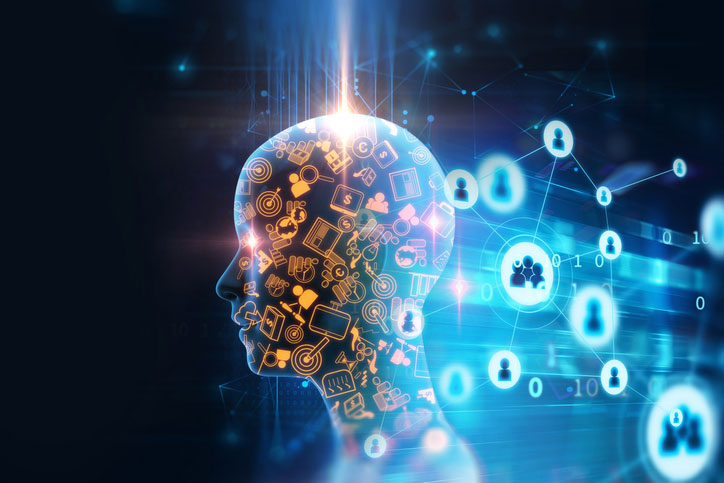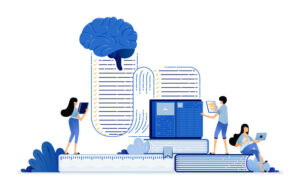Written by Scott Wilson

Who would have imagined that you would have to raise robots just like human children?
Alan Turing, for one.
The father of AI foresaw that thinking machines might learn as humans learned, through punishments and rewards as it performed tasks well or poorly. As it processed that feedback, it would alter its behavior until it had absorbed the lessons.
Turing’s expansive vision hasn’t become entirely real, but training AI has developed along very similar lines.



Just as AI scientists have tried to model artificial neural networks after the way the human brain is structured, they are trying to teach AI about the world in the same way that humans learn: repetitive exposure to various information, guided by experience, other humans, and experimentation.
That “other humans” part is where AI trainers come in.
What Is an AI Trainer?
 Training AI is a specialization that is only slowly emerging as a distinct role. Although AI model training has been a key piece of the modern renaissance in generative AI systems, all the initial AI training data was put together by AI scientists and researchers as part of their experiments. Frequently, training is still a part of AI engineering or programming roles.
Training AI is a specialization that is only slowly emerging as a distinct role. Although AI model training has been a key piece of the modern renaissance in generative AI systems, all the initial AI training data was put together by AI scientists and researchers as part of their experiments. Frequently, training is still a part of AI engineering or programming roles.
Distinct jobs training AI have only started to appear recently, as more companies have begun to spin up specialized AI systems.
AI trainers are the professionals who put together the data sets and supervise their use in training AI model algorithms.
Those specializations can matter a lot in the world of training AI models. A trainer working with chatbots to shape conversational responses and accuracy will spend a lot of time dealing with matters of linguistics and communications. One figuring out how to train voice AI will be concerned with tone and pitch subtleties alongside basic grammatical skill. And one working with self-driving algorithms will be spending time working out ways to fine-tune object recognition and the effects of various lighting and weather conditions on perception.
So AI trainers can span a range of areas of expertise, and work with all kinds of different artificial intelligence systems. Titles can include:
- Specialist in Generative AI Model Training and Inference
- Software Developer - AI Trainer
- Artificial Intelligence Trainer
How Is AI Trained?
 Machine learning is the secret sauce that enables modern generative transformers to be trained to accomplish specific tasks. The intensive research and experimentation that has brought the industry to this point has evolved a specific process for training AI algorithms.
Machine learning is the secret sauce that enables modern generative transformers to be trained to accomplish specific tasks. The intensive research and experimentation that has brought the industry to this point has evolved a specific process for training AI algorithms.
It starts with data. Even from the earliest iterations, it was clear that offering more examples to ML systems would improve their performance. Initially, that started with a process called supervised learning. AI trainers would go through data sets and label the information they wanted the algorithm to learn to recognize.
But it became clear that most algorithms needed far more data to learn effectively than could manageably be labeled. So unsupervised learning was developed: a process by which algorithms themselves would sort through unlabeled data to identify common elements or trends, which could then be identified by trainers if needed.
Finally, a third path was developed, taking some pressure off the trainers to label vast amounts of data but offering more guidance than hit-or-miss unsupervised training: reinforcement learning. In reinforcement learning systems, trainers develop feedback systems to help the algorithm understand when it is getting closer to correct solutions or drifting further from them. This kind of behavioral punishment and reward system is very similar to some psychological models of learning in animals, including humans.
Each type of learning system can be useful in different roles. It’s part of the job of AI trainers to know which to use and how to implement a system appropriate for the model they are training.
Training AI Is Still a Dark Art, With a Lot of Experimentation and Variation
 While the miracle of generative AI training has resulted in some amazing progress in the field of artificial intelligence today, it’s really still early days for AI training programs. Figuring out how to best present and optimize training data is a work in progress. AI training jobs are a big part of inventing the future of training AI models.
While the miracle of generative AI training has resulted in some amazing progress in the field of artificial intelligence today, it’s really still early days for AI training programs. Figuring out how to best present and optimize training data is a work in progress. AI training jobs are a big part of inventing the future of training AI models.
The outlines of the job are clear. AI trainers:
- Identify and collect data relevant to the purpose of the model
- Synthesize data for training where raw data is unavailable
- Clean and, if needed, arrange for annotation and labeling of the data
- Help AI engineers fine-tune algorithms and models
- Verify the output from AI training models
There aren’t clear recipes for the best ways to perform all these tasks, though. For instance, up until recently, the very idea of synthetic data for AI training was only theoretical. Actual AI trainers had to experiment and develop systems to make it possible.
The field is still evolving fast. New projects attempting to teach AI to train other AI are being launched. AI training jobs will be a dynamic role requiring adaptability and creativity.
How to Become an AI Trainer
 At this stage of the game, there’s no well-defined path to learn how to train an AI. So much of your preparation will look like any other career track in artificial intelligence today.
At this stage of the game, there’s no well-defined path to learn how to train an AI. So much of your preparation will look like any other career track in artificial intelligence today.
That always starts with a college education. Even the jobs in AI that are low on the totem pole are more advanced than those of many other industries. You need solid grounding in math, computational theory, programming, and data science to understand how to train the mind of the machine.
On-the-job experience is the next critical element for AI trainers. All the theory in the world can’t teach you the details of how to tweak algorithms or datasets for the best results. In fact, a lot of that theory comes right out of practical experience. So you’ll need to either find a related position, like AI prompt engineering, or experiment on your own to get that hard-won on-the-ground expertise.
If you want to get paid to train AI, you’ll need to develop a pretty specialized set of skills.
You’ll also need to develop specialized expertise in the area of AI and ML training you plan to work in. At the theoretical level, most generative algorithms look the same. But when it comes time to feed in data, there can be big differences in how you analyze, prepare, and assess visual versus linguistic or even more exotic training data.
Mastering the Skills Required in AI Trainer Jobs
Businesses looking for AI trainers today have a range of different skills and skill levels in mind. Some are looking for individuals who have the same essential qualifications as AI engineers:
- Strong knowledge of programming languages and concepts
- A well-developed understanding of AI theory
- Prior experience in software development
- An advanced education in computer science
In other cases, trainers are hired to interact with AI further downstream. These positions will focus on skills like:
- Language and basic reasoning skills
- Basic dialog and communication abilities
- Business experience or expertise
- Undergraduate level education in business, marketing, PR, or sales
In both cases, AI data trainers need to have a clear understanding of the three major techniques in use today. They also have to keep up with the various combinations, branches, and new developments surrounding those techniques. They also have to be able to predict which will be most useful for the goals facing the system they are training. And they have to understand AI inference vs training, generative AI training, and sometimes specialized concepts like how to train voice AI models.
AI Trainer Salary Levels Aren’t Yet Settled
 There are so few AI trainers working today in dedicated positions that there is no good source of data to cite for a typical salary level. The Bureau of Labor Statistics (BLS), which tracks job categories, employment, and compensation for positions in the United States, doesn’t even have a slot yet for AI engineers, let alone trainers.
There are so few AI trainers working today in dedicated positions that there is no good source of data to cite for a typical salary level. The Bureau of Labor Statistics (BLS), which tracks job categories, employment, and compensation for positions in the United States, doesn’t even have a slot yet for AI engineers, let alone trainers.
There are, however, related categories that already exist in the world of high tech. The closest fit to the kind of work that AI trainer jobs involve is that of quality assurance and testing positions in software development.
Of course, working in AI is like putting regular development on steroids, so most trainers will do better than the average when it comes to salary. Those in the top ten percent of QA and testing in 2022 made more than $159,740 per year.
You can learn more about the general trends and factors in AI career salaries here.
Figuring Out the Best Degrees to Earn to Learn to Train AI
 As you might imagine, there are no college degrees in how to train AI just yet. Even within data science and machine learning programs, information about how to train an AI model is in short supply. Instead, you’ll have to find a program that brings the right combination of AI, ML, and data science training to get your foot in the door.
As you might imagine, there are no college degrees in how to train AI just yet. Even within data science and machine learning programs, information about how to train an AI model is in short supply. Instead, you’ll have to find a program that brings the right combination of AI, ML, and data science training to get your foot in the door.
Training AI is a data-heavy effort, so majors that build your knowledge and skills in that direction will always be an asset. A Bachelor of Science in Data Science or Bachelor of Science in Data Analytics both fit that description.
Naturally, a Bachelor of Science in Artificial Intelligence, or Bachelor of Science in Machine Learning touch on data science as well, but with more emphasis on algorithms and coding versus manipulation and analysis.
It’s also entirely possible to get into AI training coming from the other direction. A Bachelor of Science in Computational Linguistics will set your foundations for how to train AI chatbots; a Bachelor of Science in Computer Vision will give you some of the core concepts needed for training visual recognition algorithms.
Whichever angle you are coming from, educational certificates offer a quick and focused way to build up any important skills your major missed out on. Coming out of a computer science-heavy degree, you might get a Certificate in Computational Linguistics to hit the language side of the field. Or if you’re heading to voice AI training, a Certificate in Audio Production Techniques might be useful. Naturally, there are always options like a Graduate Certificate in Artificial Intelligence and Machine Learning if you are coming from the other direction.
The Best AI Training Courses to Fit into Your AI Degree Program
 If you can’t get a full-on degree in AI training, you can at least massage your class schedule to give you a better foundation in training AI models than the average new graduate.
If you can’t get a full-on degree in AI training, you can at least massage your class schedule to give you a better foundation in training AI models than the average new graduate.
A bachelor’s degree is a great place to broaden your education in this area. With four years and a wide array of general education courses required, you can fill in your knowledge base with some out-of-the-way subjects that can be very useful to an AI data trainer.
On top of simply picking up electives in areas like language or the physics of sounds, you can build your conceptual framework with classes in developmental psychology, or theories of education. Since AI training is being built out of these concepts, you’ll get further in your studies if you learn to understand them early on.
Learning how to train AI models will put you ahead of the wave in the artificial intelligence tsunami. But the process of building a career in AI and ML training is something you’re going to have to learn yourself, along with the rest of the industry. If your idea of fun is being at the cutting edge of the cutting edge, AI training jobs are where it’s at.
2022 US Bureau of Labor Statistics salary and employment figures for Software Developers, Quality Assurance Analysts, and Testers reflect national data, not school-specific information. Conditions in your area may vary. Data accessed December 2023.





